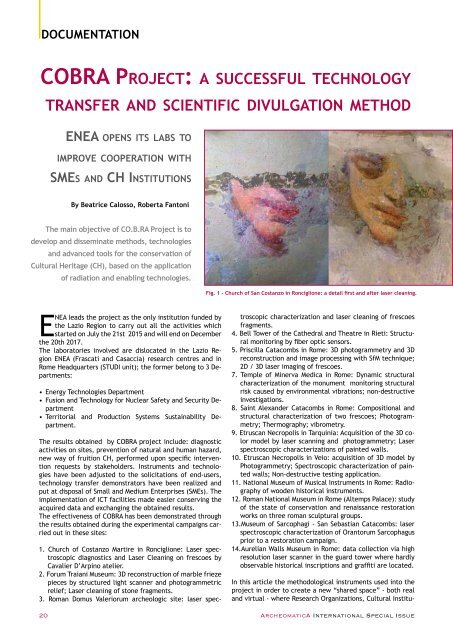Archeomatica International 2017
Special supplement to Archeomatica 3 2017
Special supplement to Archeomatica 3 2017
Create successful ePaper yourself
Turn your PDF publications into a flip-book with our unique Google optimized e-Paper software.
DOCUMENTATION<br />
COBRA Project: a successful technology<br />
transfer and scientific divulgation method<br />
ENEA opens its labs to<br />
improve cooperation with<br />
SMEs and CH Institutions<br />
By Beatrice Calosso, Roberta Fantoni<br />
The main objective of CO.B.RA Project is to<br />
develop and disseminate methods, technologies<br />
and advanced tools for the conservation of<br />
Cultural Heritage (CH), based on the application<br />
of radiation and enabling technologies.<br />
Fig. 1 - Church of San Costanzo in Ronciglione: a detail first and after laser cleaning.<br />
ENEA leads the project as the only institution funded by<br />
the Lazio Region to carry out all the activities which<br />
started on July the 21st 2015 and will end on December<br />
the 20th <strong>2017</strong>.<br />
The laboratories involved are dislocated in the Lazio Region<br />
ENEA (Frascati and Casaccia) research centres and in<br />
Rome Headquarters (STUDI unit); the former belong to 3 Departments:<br />
• Energy Technologies Department<br />
• Fusion and Technology for Nuclear Safety and Security Department<br />
• Territorial and Production Systems Sustainability Department.<br />
The results obtained by COBRA project include: diagnostic<br />
activities on sites, prevention of natural and human hazard,<br />
new way of fruition CH, performed upon specific intervention<br />
requests by stakeholders. Instruments and technologies<br />
have been adjusted to the solicitations of end-users,<br />
technology transfer demonstrators have been realized and<br />
put at disposal of Small and Medium Enterprises (SMEs). The<br />
implementation of ICT facilities made easier conserving the<br />
acquired data and exchanging the obtained results.<br />
The effectiveness of COBRA has been demonstrated through<br />
the results obtained during the experimental campaigns carried<br />
out in these sites:<br />
1. Church of Costanzo Martire in Ronciglione: Laser spectroscopic<br />
diagnostics and Laser Cleaning on frescoes by<br />
Cavalier D’Arpino atelier.<br />
2. Forum Traiani Museum: 3D reconstruction of marble frieze<br />
pieces by structured light scanner and photogrammetric<br />
relief; Laser cleaning of stone fragments.<br />
3. Roman Domus Valeriorum archeologic site: laser spec-<br />
troscopic characterization and laser cleaning of frescoes<br />
fragments.<br />
4. Bell Tower of the Cathedral and Theatre in Rieti: Structural<br />
monitoring by fiber optic sensors.<br />
5. Priscilla Catacombs in Rome: 3D photogrammetry and 3D<br />
reconstruction and image processing with SfM technique;<br />
2D / 3D laser imaging of frescoes.<br />
7. Temple of Minerva Medica in Rome: Dynamic structural<br />
characterization of the monument monitoring structural<br />
risk caused by environmental vibrations; non-destructive<br />
investigations.<br />
8. Saint Alexander Catacombs in Rome: Compositional and<br />
structural characterization of two frescoes; Photogrammetry;<br />
Thermography; vibrometry.<br />
9. Etruscan Necropolis in Tarquinia: Acquisition of the 3D color<br />
model by laser scanning and photogrammetry; Laser<br />
spectroscopic characterizations of painted walls.<br />
10. Etruscan Necropolis in Veio: acquisition of 3D model by<br />
Photogrammetry; Spectroscopic characterization of painted<br />
walls; Non-destructive testing application.<br />
11. National Museum of Musical Instruments in Rome: Radiography<br />
of wooden historical instruments.<br />
12. Roman National Museum in Rome (Altemps Palace): study<br />
of the state of conservation and renaissance restoration<br />
works on three roman sculptural groups.<br />
13.Museum of Sarcophagi - San Sebastian Catacombs: laser<br />
spectroscopic characterization of Orantorum Sarcophagus<br />
prior to a restoration campaign.<br />
14.Aurelian Walls Museum in Rome: data collection via high<br />
resolution laser scanner in the guard tower where hardly<br />
observable historical inscriptions and graffiti are located.<br />
In this article the methodological instruments used into the<br />
project in order to create a new “shared space” - both real<br />
and virtual - where Research Organizations, Cultural Institu-<br />
20 ArcheomaticA <strong>International</strong> Special Issue


















